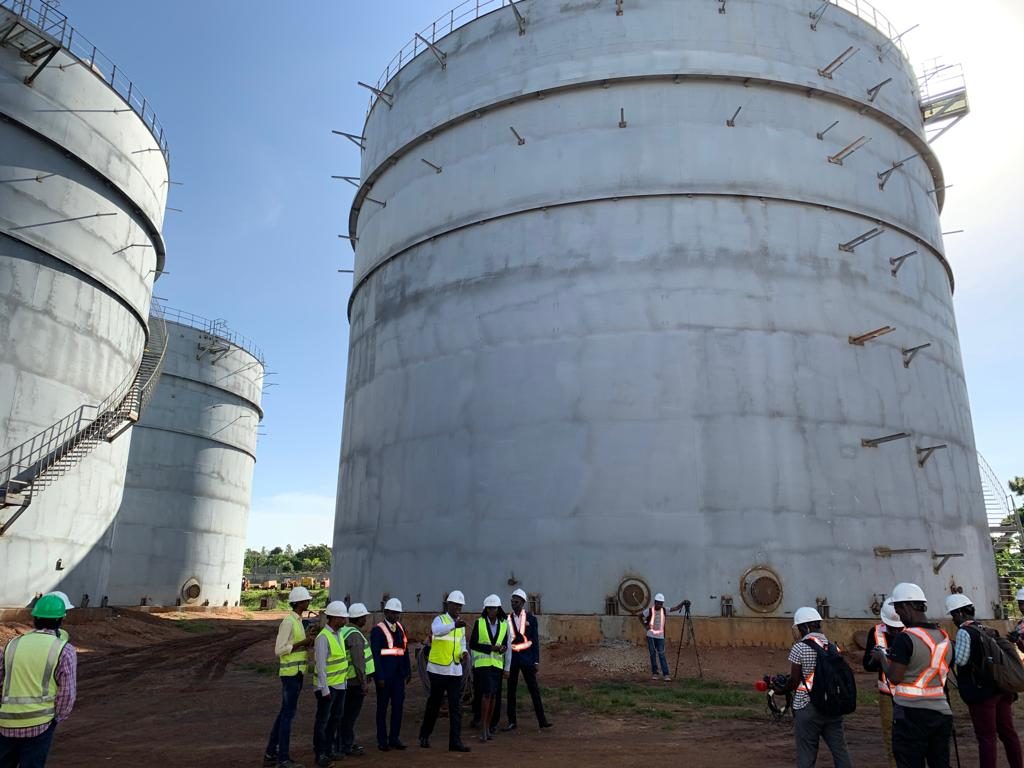The certainty in fuel supply and stability of prices is a fundamental factor in the economic growth of every economy.
Transport expenditure is a major factor of production, therefore any volatilities in either price or supply could upset households, businesses or even economies.
But this will be a thing of the past when the 70 million litre Fuel Storage Terminal and Lake Victoria Fuel Transport System, a multibillion investment at Bugiri-Bukasa, run by Mahathi Infra Uganda Limited is fully operational next year.
The facility has 14 tanks, each with a storage capacity of 9 million litres.
With 60% of the work, Mahathi Infra Uganda Limited, has already created a new petroleum transportation network along Lake Victoria.
The chairman of the Mahathi company and also NRM chairman for Eastern region Mike Mukula told this website that there are have 14 tanks and out of them, 13 are fully complete and 1 tank will be completed at the end if this month.
“With the capacity we have developed 70 million litres of fuel reserve and with what the country has in Jinja which is 30 million litres and what the local oil marketing companies have, Uganda can now have the capacity to sustain fuel points for over 30 days. Meaning that as a landlocked country we have developed a strategic capacity to be able to manage the requisite requirement for at least 20 days while other options are being developed,” he boasted.

Explaining about the jetty where the ships will dock he added, “the jetty which is 230 meters into the lake has now done 180 meters so in essence we have completed and we think that we will have the jetty ready by end of November.”
What is remaining and the critical point which the operators are tackling now is addressing the issue of ship building. There are two ships which must be ready early next year.
“And we will embark on second set of ships so by the end of year 2020 we will have four oil tankers ready.
In terms of estimate we are at 60%, we have all the necessary material on the site it only critical equipment which is on the way from Europe.
And by March or April we will have the first tracks ready here to collect fuel,” Mukula said.
On the need for transport, Mukula argues that every farmer in this country believes and uses road transport, what is important to note that this investment is a game changer because it will reduce cost of transport in the country.
“We think that addressing this core strategic investment we will be tackling what the ordinary person is and it will be transforming the economy and making Uganda a major competitive center for production because we think that having fuel dependency and capacity we will now be able to address issues of reduction of fuel costs.
Which in particular this investment will address by reducing cost of transport by 50% and we are negotiating with Kenya pipeline to see that the offtake price of fuel per litter can also be reduced so that we can have the equation in right place,” he further explained.
Middle Income
Speaking to TrumpetNews shortly after touring the site, State Minister for Investment Hon Evelyn Anite couldn’t hold up her excitement because the investment would finally trigger development in the country since Uganda has been grappling with high fuel and transport prices because of the inability to have enough fuel in the country.
“Having 14 fuel tanks and above all the exciting news of having the number one ship being built in Uganda is a mind-blowing story. This is commendable away from the jobs that this project comes with will transform the lives of our people, building shelter and paying school fees and change their life style from the employment opportunity that will be created here, there is something bigger that we will get out of this,” she said.
Adding: “The number is fuel transportation, the risk of accidents, the ship will take away the transport load of 170 trucks of fuel that enter Uganda everyday.
That means that the load on the road will be taken and therefore improve our roads.
The fuel will be cheaper because it has been taking fuel suppliers one week to transport fuel from Kenya but now it will take 16 hours.”
The operators told the Minister that they face two challenges Electricity and a smooth road that will connect the fuel reserve to the rest of Uganda.
“For electricity I will resolve the issue this week and the road will definitely be worked on.”
She noted that every time there is a political season or economic instability in the neighboring country or the country has inflation, it affects Uganda.
“The cost of fuel goes up and also shortage of fuel, now this is going to be resolved by having all these 14 tanks. Even envisaging that the country will run out of fuel is no be more.
This is a centerpiece for us as a country and I now see us reaching a middle income status,” she said.
Safety
On safety of the storage he managers revealed the terminal has been set up with best and latest technology building it on NFPA standards which is the American standard.
They are providing hydrocarbonate detecting systems, smoke detectors, fire detectors and heat detectors and ensure accuracy of the systems.
Any disturbance will be detected in its initial stage and there will be extinguishing mechanism put in place.
The fire fighting system is up to international standards and it will be the best in East Africa.